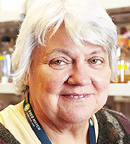Vaccination against the human papillomavirus (HPV) reduced the risk of acquiring oral HPV infections by 88%, in one of the first large studies to explore vaccination’s impact in the oropharynx. The study will be presented at the 2017 ASCO Annual Meeting, and the findings were released in advance of the meeting in an online press briefing for journalists.1

There was a notable impact of the vaccine on oral HPV infections among vaccinated individuals, but the benefit was modest overall and lower than we would hope in men.— Maura L. Gillison, MD, PhD
Tweet this quote
Maura L. Gillison, MD, PhD, Professor of Medicine at The University of Texas MD Anderson Cancer Center, led the research while she was at The Ohio State University. She reported the results of the analysis of 2,627 young adults between the ages of 18 and 33 during the period 2011 through 2014. They were drawn from the National Health and Nutrition Examination Survey (NHANES).
“Rates of HPV-caused oral cancers continue to rise every year in the United States, particularly among men. And yet, no clinical trial has evaluated the potential use of the HPV vaccine for the prevention of oral HPV infections that could lead to cancer,” Dr. Gillison said. “Given the absence of gold-standard clinical trial data, we investigated whether HPV vaccine has had an impact on oral HPV infections among young adults in America.”
The researchers compared young adults (aged 18–33) who self-reported having received at least one dose of an HPV vaccine with those who had not been vaccinated. They focused on the prevalence of infection with the four HPV types (16, 18, 6, and 11) that were included in the HPV vaccine prior to 2016 (today, five additional strains are covered). HPV infection was detected from oral rinse samples, which were collected by mobile health facilities supported by NHANES. The laboratory tests for HPV infection were developed and performed in Dr. Gillison’s laboratory.
Low Vaccination Rates, High Protection Rates
“HPV vaccination substantially reduced vaccine-type oral HPV infection prevalence among young adults,” Dr. Gillison reported. “However, due to low vaccine uptake, population-level effectiveness was modest overall and particularly low in men.”
Between 2011 and 2014, fewer than 1 in 5 (18.3%) young adults reported receiving at least a single dose of the HPV vaccine before age 26. The vaccination rate during that period was much lower among men than women (6.9% vs 29.2%; P < .001).
Those who did become immunized, however, were apparently protected against oral HPV infection, the population-weighted prevalence of which was 0.11% among vaccinated persons and 1.61% among unvaccinated persons (P = .008). This finding translated into an 88% reduction in the oral HPV infection with vaccination.
Notably, in men—where most of the risk of HPV-related oropharyngeal cancer lies—the prevalence rates were 0.0% among vaccinated individuals and 2.13% among unvaccinated persons (P = .007).
In contrast, the prevalence of oral infection with 33 HPV types that were not covered by the vaccine given at the time was similar between vaccinated (3.98%) and unvaccinated (4.74%) groups, further demonstrating the vaccine’s efficacy.
HPV Vaccination and Oral Infections
- Analysis of an NHANES database of 2,627 young adults showed low rates of vaccination against human papillomavirus (HPV) between 2011 and 2014.
- During that period, 18% of adults aged 18 to 33 had received at least one dose of an HPV vaccine covering types 16, 18, 6, and 11.
- Individuals who were vaccinated, however, were 88% less likely to develop an oral HPV infection.
- Oral HPV infection rates were 0.11% for vaccinated persons, vs 1.61% for unvaccinated persons.
Due to the low uptake of the HPV vaccine as reported by NHANES between 2011 and 2014, Dr. Gillison and her team estimated that the impact of vaccination on the prevalence of vaccine-covered, oral HPV infections in the general population was “modest,” reducing the prevalence overall by 17% and by 25% in women and by about 7% in men.
“While we were encouraged there was a notable impact of the vaccine on oral HPV infections among vaccinated individuals, that benefit was modest overall and lower than we would hope in men, due to low vaccine uptake,” she said.
Whether vaccination will translate into not only a reduction in HPV infection but a reduction in HPV-related oropharyngeal cancers is unknown, but as “one of the most important advances in cancer prevention in the past several decades,” this is the hope, concluded Dr. Gillison. ■
Disclosure: Dr. Gillison has had a consulting or advisory role with Amgen, AstraZeneca, Bristol-Myers Squibb, Celgene, GlaxoSmithKline, Lilly, and Merck, and has received institutional research funding from AstraZeneca, Bristol-Myers Squibb, Kyowa Hakko Kirin, and Merck.
Reference


